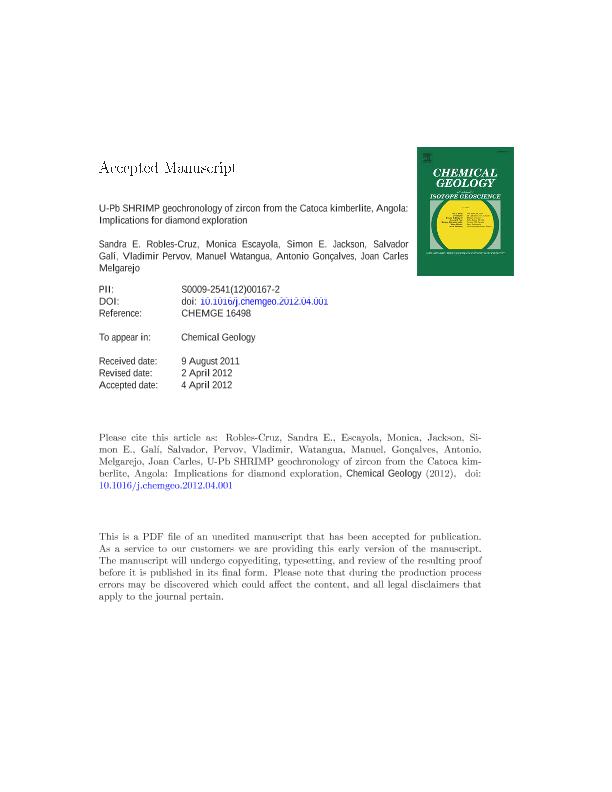Mostrar el registro sencillo del ítem
dc.contributor.author
Robles-Cruz, Sandra E.
dc.contributor.author
Escayola, Monica Patricia

dc.contributor.author
Jackson, Simon
dc.contributor.author
Galí, Salvador
dc.contributor.author
Pervov, Vladimir
dc.contributor.author
Watangua, Manuel
dc.contributor.author
Gonçalves, Antonio
dc.contributor.author
Melgarejo, Joan Carles
dc.date.available
2019-10-03T19:36:14Z
dc.date.issued
2012-06
dc.identifier.citation
Robles-Cruz, Sandra E.; Escayola, Monica Patricia; Jackson, Simon; Galí, Salvador; Pervov, Vladimir; et al.; U-Pb SHRIMP geochronology of zircon from the Catoca kimberlite, Angola: Implications for diamond exploration; Elsevier Science; Chemical Geology; 310-311; 6-2012; 137-147
dc.identifier.issn
0009-2541
dc.identifier.uri
http://hdl.handle.net/11336/85160
dc.description.abstract
We present the first age determinations of zircon from the diamondiferous Catoca kimberlite in northeastern Angola, the fourth largest kimberlite body in the world. The U-Pb ages were obtained using a Sensitive High Resolution Ion Microprobe II (SHRIMP II) on zircon crystals derived from tuffisitic kimberlite rocks and heavy-mineral concentrates from the Catoca kimberlite. The SHRIMP results define a single weighted mean age of 117.9. ± 0.7 Ma (Mean square weighted deviation MSWD = 1.3). More than 90% of the results indicate a single age population. There is no evidence for variable ages within single crystals, and no diffusional profiles are preserved. These data are interpreted as the maximum age of the kimberlite eruption at Catoca. The U/Th values suggest at least two different sources of zircon crystals. These different populations may reflect different sources of kimberlitic magma, with some of the grains produced in U- and Th-enriched metasomatized mantle units. This idea is consistent with the two populations of zircon identified in this study. One population originated from a depleted mantle source with low total REE (less than 25. ppm), and the other was derived from an enriched source, likely from the mantle or a carbonatite-like melt with high total REE (up to 123. ppm).The tectonic setting of northeastern Angola is influenced by the opening of the south Atlantic, which reactivated deep NE-SW-trending faults during the early Cretaceous. The eruption of the Catoca kimberlite can be correlated with these regional tectonic events. The Calonda Formation (Albian-Cenomanian age) is the earliest sedimentary unit that incorporates eroded material derived from the diamondiferous kimberlites. Thus, the age of the Catoca kimberlite eruption is restricted to the time between the middle of the Aptian and the Albian. The new interpretation will be an important guide in future exploration for diamonds because it provides precise data on the age of a diamond-bearing kimberlite pulse in Angola.
dc.format
application/pdf
dc.language.iso
eng
dc.publisher
Elsevier Science

dc.rights
info:eu-repo/semantics/openAccess
dc.rights.uri
https://creativecommons.org/licenses/by-nc-sa/2.5/ar/
dc.rights.uri
https://creativecommons.org/licenses/by-nc-sa/2.5/ar/
dc.subject
CATOCA KIMBERLITE
dc.subject
DIAMOND
dc.subject
GEOCHRONOLOGY
dc.subject
SHRIMP
dc.subject
U-PB DATING
dc.subject
ZIRCON
dc.subject.classification
Geoquímica y Geofísica

dc.subject.classification
Ciencias de la Tierra y relacionadas con el Medio Ambiente

dc.subject.classification
CIENCIAS NATURALES Y EXACTAS

dc.title
U-Pb SHRIMP geochronology of zircon from the Catoca kimberlite, Angola: Implications for diamond exploration
dc.type
info:eu-repo/semantics/article
dc.type
info:ar-repo/semantics/artículo
dc.type
info:eu-repo/semantics/publishedVersion
dc.date.updated
2019-09-27T15:02:17Z
dc.journal.volume
310-311
dc.journal.pagination
137-147
dc.journal.pais
Países Bajos

dc.journal.ciudad
Amsterdam
dc.description.fil
Fil: Robles-Cruz, Sandra E.. Universidad de Barcelona; España
dc.description.fil
Fil: Escayola, Monica Patricia. Consejo Nacional de Investigaciones Científicas y Técnicas. Oficina de Coordinación Administrativa Ciudad Universitaria. Instituto de Estudios Andinos "Don Pablo Groeber". Universidad de Buenos Aires. Facultad de Ciencias Exactas y Naturales. Instituto de Estudios Andinos "Don Pablo Groeber"; Argentina
dc.description.fil
Fil: Jackson, Simon. Geological Survey Of Canada; Canadá
dc.description.fil
Fil: Galí, Salvador. Universidad de Barcelona; España
dc.description.fil
Fil: Pervov, Vladimir. Sociedade Mineira de Catoca; Angola
dc.description.fil
Fil: Watangua, Manuel. Universidade Agostinho Neto; Angola
dc.description.fil
Fil: Gonçalves, Antonio. Universidade Agostinho Neto; Angola
dc.description.fil
Fil: Melgarejo, Joan Carles. Universidad de Barcelona; España
dc.journal.title
Chemical Geology

dc.relation.alternativeid
info:eu-repo/semantics/altIdentifier/doi/http://dx.doi.org/10.1016/j.chemgeo.2012.04.001
dc.relation.alternativeid
info:eu-repo/semantics/altIdentifier/url/https://www.sciencedirect.com/science/article/pii/S0009254112001672
Archivos asociados
